Ranjay Krishna
GenEval 2: Addressing Benchmark Drift in Text-to-Image Evaluation
Dec 18, 2025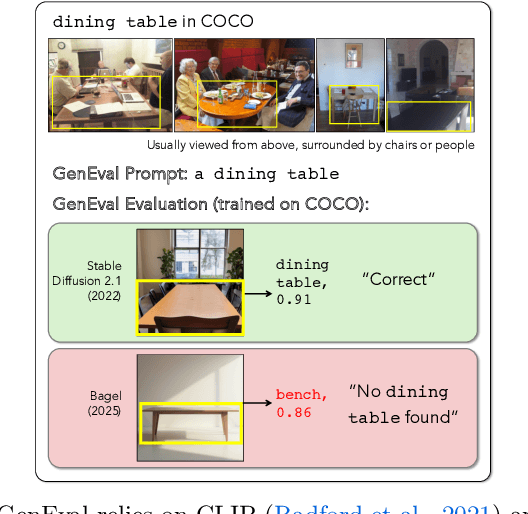
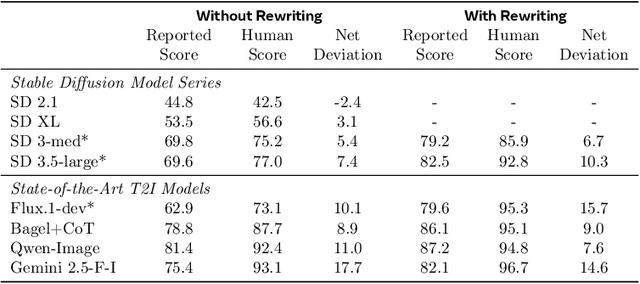
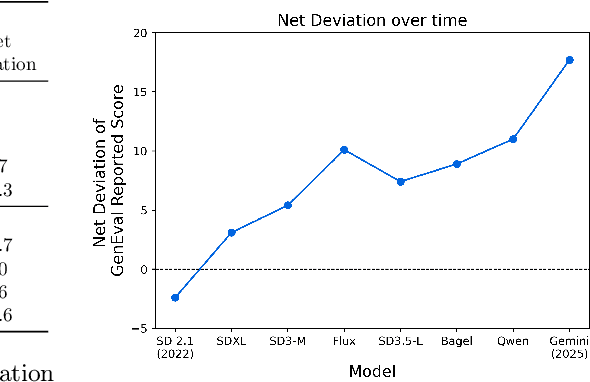
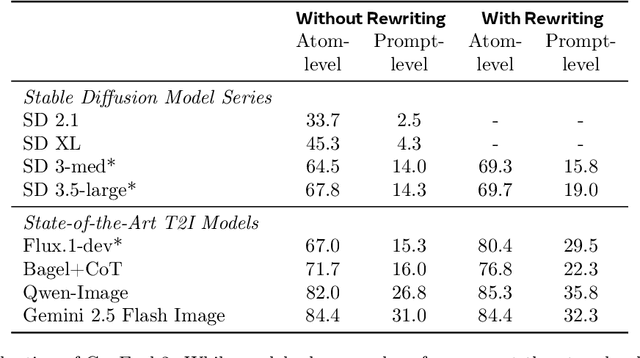
Abstract:Automating Text-to-Image (T2I) model evaluation is challenging; a judge model must be used to score correctness, and test prompts must be selected to be challenging for current T2I models but not the judge. We argue that satisfying these constraints can lead to benchmark drift over time, where the static benchmark judges fail to keep up with newer model capabilities. We show that benchmark drift is a significant problem for GenEval, one of the most popular T2I benchmarks. Although GenEval was well-aligned with human judgment at the time of its release, it has drifted far from human judgment over time -- resulting in an absolute error of as much as 17.7% for current models. This level of drift strongly suggests that GenEval has been saturated for some time, as we verify via a large-scale human study. To help fill this benchmarking gap, we introduce a new benchmark, GenEval 2, with improved coverage of primitive visual concepts and higher degrees of compositionality, which we show is more challenging for current models. We also introduce Soft-TIFA, an evaluation method for GenEval 2 that combines judgments for visual primitives, which we show is more well-aligned with human judgment and argue is less likely to drift from human-alignment over time (as compared to more holistic judges such as VQAScore). Although we hope GenEval 2 will provide a strong benchmark for many years, avoiding benchmark drift is far from guaranteed and our work, more generally, highlights the importance of continual audits and improvement for T2I and related automated model evaluation benchmarks.
Structure From Tracking: Distilling Structure-Preserving Motion for Video Generation
Dec 12, 2025Abstract:Reality is a dance between rigid constraints and deformable structures. For video models, that means generating motion that preserves fidelity as well as structure. Despite progress in diffusion models, producing realistic structure-preserving motion remains challenging, especially for articulated and deformable objects such as humans and animals. Scaling training data alone, so far, has failed to resolve physically implausible transitions. Existing approaches rely on conditioning with noisy motion representations, such as optical flow or skeletons extracted using an external imperfect model. To address these challenges, we introduce an algorithm to distill structure-preserving motion priors from an autoregressive video tracking model (SAM2) into a bidirectional video diffusion model (CogVideoX). With our method, we train SAM2VideoX, which contains two innovations: (1) a bidirectional feature fusion module that extracts global structure-preserving motion priors from a recurrent model like SAM2; (2) a Local Gram Flow loss that aligns how local features move together. Experiments on VBench and in human studies show that SAM2VideoX delivers consistent gains (+2.60\% on VBench, 21-22\% lower FVD, and 71.4\% human preference) over prior baselines. Specifically, on VBench, we achieve 95.51\%, surpassing REPA (92.91\%) by 2.60\%, and reduce FVD to 360.57, a 21.20\% and 22.46\% improvement over REPA- and LoRA-finetuning, respectively. The project website can be found at https://sam2videox.github.io/ .
Agile Deliberation: Concept Deliberation for Subjective Visual Classification
Dec 11, 2025Abstract:From content moderation to content curation, applications requiring vision classifiers for visual concepts are rapidly expanding. Existing human-in-the-loop approaches typically assume users begin with a clear, stable concept understanding to be able to provide high-quality supervision. In reality, users often start with a vague idea and must iteratively refine it through "concept deliberation", a practice we uncovered through structured interviews with content moderation experts. We operationalize the common strategies in deliberation used by real content moderators into a human-in-the-loop framework called "Agile Deliberation" that explicitly supports evolving and subjective concepts. The system supports users in defining the concept for themselves by exposing them to borderline cases. The system does this with two deliberation stages: (1) concept scoping, which decomposes the initial concept into a structured hierarchy of sub-concepts, and (2) concept iteration, which surfaces semantically borderline examples for user reflection and feedback to iteratively align an image classifier with the user's evolving intent. Since concept deliberation is inherently subjective and interactive, we painstakingly evaluate the framework through 18 user sessions, each 1.5h long, rather than standard benchmarking datasets. We find that Agile Deliberation achieves 7.5% higher F1 scores than automated decomposition baselines and more than 3% higher than manual deliberation, while participants reported clearer conceptual understanding and lower cognitive effort.
OmniView: An All-Seeing Diffusion Model for 3D and 4D View Synthesis
Dec 11, 2025Abstract:Prior approaches injecting camera control into diffusion models have focused on specific subsets of 4D consistency tasks: novel view synthesis, text-to-video with camera control, image-to-video, amongst others. Therefore, these fragmented approaches are trained on disjoint slices of available 3D/4D data. We introduce OmniView, a unified framework that generalizes across a wide range of 4D consistency tasks. Our method separately represents space, time, and view conditions, enabling flexible combinations of these inputs. For example, OmniView can synthesize novel views from static, dynamic, and multiview inputs, extrapolate trajectories forward and backward in time, and create videos from text or image prompts with full camera control. OmniView is competitive with task-specific models across diverse benchmarks and metrics, improving image quality scores among camera-conditioned diffusion models by up to 33\% in multiview NVS LLFF dataset, 60\% in dynamic NVS Neural 3D Video benchmark, 20\% in static camera control on RE-10K, and reducing camera trajectory errors by 4x in text-conditioned video generation. With strong generalizability in one model, OmniView demonstrates the feasibility of a generalist 4D video model. Project page is available at https://snap-research.github.io/OmniView/
Mull-Tokens: Modality-Agnostic Latent Thinking
Dec 11, 2025Abstract:Reasoning goes beyond language; the real world requires reasoning about space, time, affordances, and much more that words alone cannot convey. Existing multimodal models exploring the potential of reasoning with images are brittle and do not scale. They rely on calling specialist tools, costly generation of images, or handcrafted reasoning data to switch between text and image thoughts. Instead, we offer a simpler alternative -- Mull-Tokens -- modality-agnostic latent tokens pre-trained to hold intermediate information in either image or text modalities to let the model think free-form towards the correct answer. We investigate best practices to train Mull-Tokens inspired by latent reasoning frameworks. We first train Mull-Tokens using supervision from interleaved text-image traces, and then fine-tune without any supervision by only using the final answers. Across four challenging spatial reasoning benchmarks involving tasks such as solving puzzles and taking different perspectives, we demonstrate that Mull-Tokens improve upon several baselines utilizing text-only reasoning or interleaved image-text reasoning, achieving a +3% average improvement and up to +16% on a puzzle solving reasoning-heavy split compared to our strongest baseline. Adding to conversations around challenges in grounding textual and visual reasoning, Mull-Tokens offers a simple solution to abstractly think in multiple modalities.
OlmoEarth: Stable Latent Image Modeling for Multimodal Earth Observation
Nov 17, 2025Abstract:Earth observation data presents a unique challenge: it is spatial like images, sequential like video or text, and highly multimodal. We present OlmoEarth: a multimodal, spatio-temporal foundation model that employs a novel self-supervised learning formulation, masking strategy, and loss all designed for the Earth observation domain. OlmoEarth achieves state-of-the-art performance compared to 12 other foundation models across a variety of research benchmarks and real-world tasks from external partners. When evaluating embeddings OlmoEarth achieves the best performance on 15 out of 24 tasks, and with full fine-tuning it is the best on 19 of 29 tasks. We deploy OlmoEarth as the backbone of an end-to-end platform for data collection, labeling, training, and inference of Earth observation models. The OlmoEarth Platform puts frontier foundation models and powerful data management tools into the hands of non-profits and NGOs working to solve the world's biggest problems. OlmoEarth source code, training data, and pre-trained weights are available at $\href{https://github.com/allenai/olmoearth_pretrain}{\text{https://github.com/allenai/olmoearth_pretrain}}$.
SIMS-V: Simulated Instruction-Tuning for Spatial Video Understanding
Nov 06, 2025Abstract:Despite impressive high-level video comprehension, multimodal language models struggle with spatial reasoning across time and space. While current spatial training approaches rely on real-world video data, obtaining diverse footage with precise spatial annotations remains a bottleneck. To alleviate this bottleneck, we present SIMS-V -- a systematic data-generation framework that leverages the privileged information of 3D simulators to create spatially-rich video training data for multimodal language models. Using this framework, we investigate which properties of simulated data drive effective real-world transfer through systematic ablations of question types, mixes, and scales. We identify a minimal set of three question categories (metric measurement, perspective-dependent reasoning, and temporal tracking) that prove most effective for developing transferable spatial intelligence, outperforming comprehensive coverage despite using fewer question types. These insights enable highly efficient training: our 7B-parameter video LLM fine-tuned on just 25K simulated examples outperforms the larger 72B baseline and achieves competitive performance with proprietary models on rigorous real-world spatial reasoning benchmarks. Our approach demonstrates robust generalization, maintaining performance on general video understanding while showing substantial improvements on embodied and real-world spatial tasks.
ThinkMorph: Emergent Properties in Multimodal Interleaved Chain-of-Thought Reasoning
Oct 30, 2025
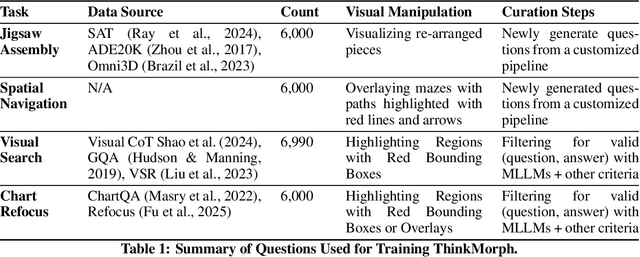
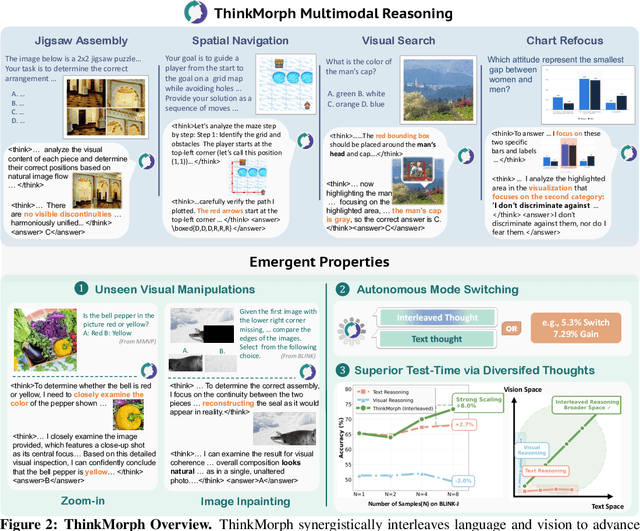

Abstract:Multimodal reasoning requires iterative coordination between language and vision, yet it remains unclear what constitutes a meaningful interleaved chain of thought. We posit that text and image thoughts should function as complementary, rather than isomorphic, modalities that mutually advance reasoning. Guided by this principle, we build ThinkMorph, a unified model fine-tuned on 24K high-quality interleaved reasoning traces spanning tasks with varying visual engagement. ThinkMorph learns to generate progressive text-image reasoning steps that concretely manipulate visual content while maintaining coherent verbal logic. It delivers large gains on vision-centric benchmarks (averaging 34.7% over the base model) and generalizes to out-of-domain tasks, matching or surpassing larger and proprietary VLMs. Beyond performance, ThinkMorph exhibits emergent multimodal intelligence, including unseen visual manipulation skills, adaptive switching between reasoning modes, and better test-time scaling through diversified multimodal thoughts.These findings suggest promising directions for characterizing the emergent capabilities of unified models for multimodal reasoning.
Visual Representations inside the Language Model
Oct 06, 2025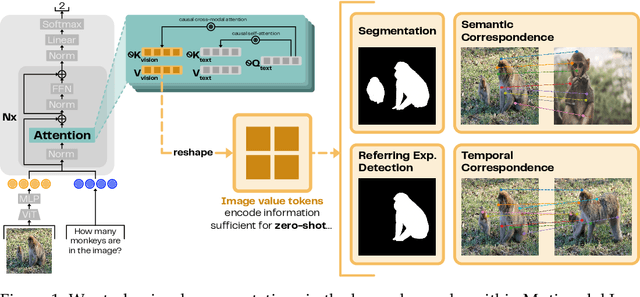



Abstract:Despite interpretability work analyzing VIT encoders and transformer activations, we don't yet understand why Multimodal Language Models (MLMs) struggle on perception-heavy tasks. We offer an under-studied perspective by examining how popular MLMs (LLaVA-OneVision, Qwen2.5-VL, and Llama-3-LLaVA-NeXT) process their visual key-value tokens. We first study the flow of visual information through the language model, finding that image value tokens encode sufficient information to perform several perception-heavy tasks zero-shot: segmentation, semantic correspondence, temporal correspondence, and referring expression detection. We find that while the language model does augment the visual information received from the projection of input visual encodings-which we reveal correlates with overall MLM perception capability-it contains less visual information on several tasks than the equivalent visual encoder (SigLIP) that has not undergone MLM finetuning. Further, we find that the visual information corresponding to input-agnostic image key tokens in later layers of language models contains artifacts which reduce perception capability of the overall MLM. Next, we discuss controlling visual information in the language model, showing that adding a text prefix to the image input improves perception capabilities of visual representations. Finally, we reveal that if language models were able to better control their visual information, their perception would significantly improve; e.g., in 33.3% of Art Style questions in the BLINK benchmark, perception information present in the language model is not surfaced to the output! Our findings reveal insights into the role of key-value tokens in multimodal systems, paving the way for deeper mechanistic interpretability of MLMs and suggesting new directions for training their visual encoder and language model components.
FailSafe: Reasoning and Recovery from Failures in Vision-Language-Action Models
Oct 02, 2025Abstract:Recent advances in robotic manipulation have integrated low-level robotic control into Vision-Language Models (VLMs), extending them into Vision-Language-Action (VLA) models. Although state-of-the-art VLAs achieve strong performance in downstream robotic applications, supported by large-scale crowd-sourced robot training data, they still inevitably encounter failures during execution. Enabling robots to reason about and recover from unpredictable and abrupt failures remains a critical challenge. Existing robotic manipulation datasets, collected in either simulation or the real world, primarily provide only ground-truth trajectories, leaving robots unable to recover once failures occur. Moreover, the few datasets that address failure detection typically offer only textual explanations, which are difficult to utilize directly in VLA models. To address this gap, we introduce FailSafe, a novel failure generation and recovery system that automatically produces diverse failure cases paired with executable recovery actions. FailSafe can be seamlessly applied to any manipulation task in any simulator, enabling scalable creation of failure-action data. To demonstrate its effectiveness, we fine-tune LLaVa-OneVision-7B (LLaVa-OV-7B) to build FailSafe-VLM. Experimental results show that FailSafe-VLM successfully helps robotic arm detect and recover from potential failures, improving the performance of three state-of-the-art VLA models pi0-FAST, OpenVLA, OpenVLA-OFT) by up to 22.6% on average across several tasks in Maniskill. Furthermore, FailSafe-VLM could generalize across different spatial configurations, camera viewpoints, and robotic embodiments. We plan to release the FailSafe code to the community.
 Add to Chrome
Add to Chrome Add to Firefox
Add to Firefox Add to Edge
Add to Edge